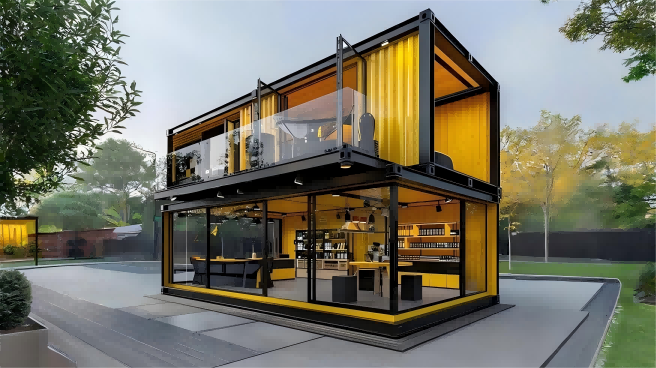Container Homes: A Trillion-Dollar Blue Ocean Market Reshaping
Commercial Spaces with Low-Carbon Innovation
“How much profit can you make by purchasing a container house?” ——This is the burning question for every overseas buyer. In reality, container housing has evolved from being merely a “temporary construction substitute” into a “low-risk profit tool” for international entrepreneurs, businesses, and organizations. From Australian homestays achieving three-month ROI to Berlin’s commercial clusters generating annual revenues of millions, countless success stories prove: Choosing the right container housing allows you to ride the three major trends of “cost optimization, scenario monetization, and policy incentives,” turning every investment into tangible returns.
I. Buy and Earn: 3 major cost advantages, half the start-up capital
For buyers, “saving money equals making money”. Container housing provides precise cost control throughout the entire process from procurement to implementation, enabling small budgets to drive large projects.
1. The procurement cost is cut in half and the budget is not overspent
New box cost performance: standardized prefabricated new box, the price is only 50% of the traditional brick and concrete building, 40 feet high box (about 28㎡) purchase price as low as $8,000-12,000, combined with bulk purchase discount, the cost is reduced by 15%;
High cost performance of second-hand containers: high quality second-hand containers can be transformed at a price of only $3,000-6,000 per container, which is equivalent to “using 1/3 of the cost to have the same space”, which is especially suitable for trial and error in the initial stage.
2. Reduce the burden of landing costs and no hidden expenses
No need to worry about “can afford to build”:
Simple foundation: only simple cement hardening or steel structure support is required, and the cost of container housing is controlled within $1,000 per box;
Rapid installation: two people can complete the lifting and fixing of a box in one day, saving 70% of labor cost compared with traditional construction
Global adaptation: customizable rock wool insulation layer (suitable for cold northern Europe), anticorrosive coating (suitable for hot and humid Southeast Asia), no additional modification is required later.
3. Zero time cost, early opening, early profit
From order to operation, it can be done in 15 days at the earliest:
Factory prefabrication: complete structural reinforcement and water and electricity pre-installation in advance, and connect soft packaging after receiving the container housing;
Start early in the peak season: Start one month before the peak season such as Christmas and summer vacation, earn 30% more revenue in the peak season, and easily cover the procurement cost.
II. Multi-scenario realization: 1 set of Container housing=N ways to make profits, and the assets are not idle
Buying one Container housing is equivalent to having a “mobile earning space”, which can be adapted to more than 80% of overseas profit scenarios, and can be flexibly switched without waste.
1. Cultural tourism accommodation: Create a famous IP, the price is 20% higher
Profitability of homestay: A buyer from California, USA purchased 640-foot Container houses and transformed them into 3 “industrial style sea view homestays”. The Booking score was 4.9, the price was $180 / night (the traditional homestay around was $150 / night), the occupancy rate was 95% in peak season, and the monthly revenue was more than $40,000;
Campground value-added: Australian buyers have converted five Container houses into “parent-child camping suites” with a terrace and barbecue area. The price is $250 per night, and the rooms are fully booked one month in advance on weekends.
2. Commercial retail: Grab core traffic and save 40% on rent
Fast Flash Shop Profit: A Singaporean buyer put two container shops on Orchard Road, selling handmade coffee and cultural and creative products. The rent is only 60% of the surrounding stores, with an average daily passenger flow of more than 500, and a monthly net profit of more than $15,000;
Exhibition realization: German buyers customized 3 container exhibition halls for Frankfurt Motor Show, which were built 7 days in advance and received more than 2000 customers. The order conversion rate was 50% higher than that of fixed exhibition halls.
3. Government-enterprise cooperation: undertaking orders and stabilizing long-term profits
Emergency order: European buyers provide 200 Container Showrooms for the government as resettlement housing, with delivery within 72 hours. Each Container Showroom will receive a government subsidy of $1,000 per set, and subsequent maintenance orders will be locked;
Enterprise procurement: provide dormitories for mines and construction sites. The monthly rent of a single Container Showrooms is 300-500 US dollars, and the annual rent of a combination of 10 Container Showrooms is more than 30,000 US dollars. The contract can be paid back in three years.
III. Policy dividends: Environmental protection label = real money, extra subsidies
Overseas “green building” policies have been introduced intensively. Buying Container housing is not only compliant, but also can get subsidies and tax incentives to earn more “policy money”.
1. Take government subsidies to reduce procurement costs by 10% -20%
EU: Projects that meet the “Green Building Standards” will receive a subsidy of €1,000-1,500 per Container Showroom;
Canada: Environmental protection renovation Container housing, each box can receive a subsidy of 1500 Canadian dollars;
United States: Companies that have LEED certified projects will receive a corporate income tax reduction of 3% to 8%.
2. Brand premium, consumers are willing to pay more
The Nordic buyers transformed the Container Showrooms into an “eco-friendly cafe”, focusing on “recycling of waste boxes”. The unit price of customers was 15% higher than that of surrounding areas, and the Z generation accounted for 70% of the customers;
A cluster of shops in Berlin created a “sustainable business district” with 15 Container Showrooms, which was reported by Dezeen, received free exposure more than 50 times, and the rent for investment increased by 20%.
IV. 2025 Buyer Action Guide: 3 Steps to Choose the Right Container Showrooms and Profit Quickly
1. Identify the profit scenario and choose the right product type
|
Scenario for profit |
Recommended chassis types |
Core configuration requirements |
Current cycle |
|
B&B/Camping |
40ft high box |
Insulation and sound insulation + terrace + integrated bathroom |
3-6 months |
|
Pop-up store/exhibition hall |
20ft standard container |
Large area of Windows + movable chassis |
2-4 months |
|
Site dormitory/Resettlement housing |
30ft high box |
Multiple beds + basic bathroom + anticorrosion coating |
6-8 months |
2. Connect with professional suppliers to avoid risks
Select “full chain service” suppliers: provide design, production, overseas transportation, local installation guidance, to avoid “no one to manage after procurement”; confirm compliance certification: require ISO, ASTM quality certification, and compliance report of the target country (such as ICC in the United States, CE in the European Union).
3. Lock in policy dividends and apply for additional benefits
Consult the supplier for the “Target Country Policy Guide” before placing an order, focusing on:
Local environmental protection subsidy application process;
Materials required for approval of temporary buildings;
Conditions for tax return declaration.
Take action: Get your profit plan for free
Now consult, free access to 3 value-added services:
Target country “Container housing Profit Scenario Measurement Table” (including cost/benefit/recovery cycle);
3 sets of popular design schemes (homestay/shops/offices);
Overseas transportation + customs clearance cost statement.
Post time: Sep-23-2025






